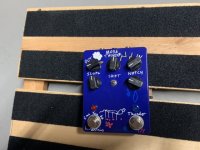My pedal is very loud. Unity is with the IN and OUT barely cracked open. If I put them at 9 o’clock, the volume increase launches me into the next room.
Tone wise, it sounds correct. It is just ridiculously loud.
Does anyone have a same or different experience?
**Edit: The picture below is unity volume, where 7 o’clock would be OFF, you can see the in and out controls are barely bumped open.
Dan

Tone wise, it sounds correct. It is just ridiculously loud.
Does anyone have a same or different experience?
**Edit: The picture below is unity volume, where 7 o’clock would be OFF, you can see the in and out controls are barely bumped open.
Dan

Last edited:

